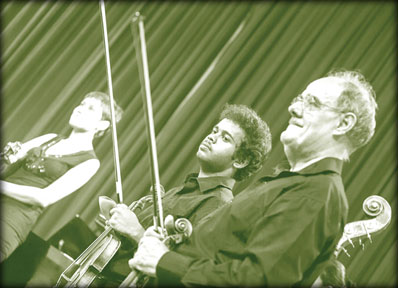The Chamber Music Society and the ‘Art of the Sonata’
by Chamath Divitotawela
The fourth concert of the critically acclaimed “Chamber Music Plus”
series was held on the February 9 at the Goethe Institute Hall in
Colombo. It was a presentation of the Chamber Music Society of Colombo,
sponsored by Concerts Norway through the Royal Norwegian Embassy and the
Goethe Institut, Colombo.
 |
|
The concert in progress |
The concert entitled “The Art of the Sonata” began with obscure
Gottfried Finger’s (ca. 1660 – August 31 1730) Sonata in C for Trumpet
and Oboe. Naveen Fernando, principal trumpet of the CMSC and Hasitha
Pathirana, principal oboist of the CMSC handled the solo parts and were
accompanied by cembalo and continuo. Gottfried Finger was a native
Moravian Baroque composer who later migrated to England in around 1685
to serve in king James the 2nd’s court and Catholic church.
The Sonata performed was typical of the examples of the era and
comprised a series of delightful dances. The playing of the soloists was
invigorating and enjoyable, but a slightly more baroque-style of cello
bowing would have been ideal.
The Gottfried Finger was followed by an early piano sonata of Muzio
Clementi’s, (January 24 1752 – March 10 1832) the prolific late
classical composer. Eshantha Peiris who is a well respected multi-genre
musician and also the CMSC’s primary keyboardist, chose to approach the
Clementi Sonata with a musical and technical reticence that suited the
music well. The balance between left and right hands and subdued use of
pedal was appreciated. What was also illuminating was the Clementi
sonata’s early use of the gradually developing theoretically accurate
‘sonata form’.
Next on was one of the well-known Sonata’s ever composed in the
Romantic era, Johannes Brahms’s ( May 7 1833 – April 3 1897) sublime
violin and piano sonata in A, op. 100. Performed admirably by Satish
Casie Chetty, a high ranking violinist of the Chamber Music Society and
Eshantha Peiris on piano. Here is a Sonata that contains some of the
best Chamber music ever written, certainly some of the most intimate
sounds to come from both violin and piano together in a romantic era
setting. Satish’s performance was slightly musically underplayed, but
perhaps that approach worked, the A major Sonata of Brahms in particular
not requiring too much extroverted dramatics. Eshantha’s equal
contribution towards the entire interpretation was apt and
complimentary. The acoustics at the middle to back of the Goethe Hall
are not very favorable to musicians and instruments that are not
projected with purpose. We did feel that from where we were sitting, the
sound of the violin on the whole could have been just slightly more
upfront.
Next on offer was a very unusual piece of music with the title
Sonata. A work for trombone and piano by a contemporary Austrian
composer named Siedler. Not very much can be said of this composer since
there are no program notes distributed at ‘Chamber Music Plus’ concerts,
most of the relevant information being verbalised on stage by the
musicians.
As the music went, the Sonata was intriguing, firstly, the sound of
the trombone, played that evening by the concert-master of the CMSC,
Lakshman Joseph de Saram, who insisted that he was not a multi
instrumentalist, but liked to moonlight occasionally on the trombone
which he studied as a second instrument under the principal bass
trombonist of the Met Opera Orchestra in NYC. The playing was in turns,
sonorous, brash, and quite agile for such a large and unwieldy
contraption of moving tubes, slides and valves. Compositionally, it
lacked to some extent, a coherent musical form, the individual movements
not really holding together to form any sort of structural identity.
However, the playing was competent and we were appreciative of the
opportunity to listen live to an instrument that is not featured too
often on the concert stage.
For the finale, as always, the CMSC brought out the heavy weaponry,
this time in the guise of the finest string section in the country
performing Heinrich Franz Biber’s (August 12 - May 3 1704) spectacularly
innovative Battalia no. 10 in D major. Biber, a Bohemian-Austrian
composer best known for his ‘Mystery Sonatas‘ for solo violin, was one
of the most prominent Baroque composers for violin and string
instruments. His ‘Battalia’ for string ensemble was truly astonishing,
all sorts of beguiling ‘special effects’ including the extremely rare
requirement of having the double bassist play her instrument having
placed a piece of sheet music between two strings to simulate the sound
of a snare drum on a battle field! The music was intoxicating, and the
playing, brimming full of bravado and technical brilliance.
The CMSC seems to have a monopoly on the most dedicated and erudite
audience in this city, rain or shine, it is always a well-heeled full
house displaying the most sophisticated concert etiquette. No ring
tones, and no condescending announcements from the stage on that subject
either. No idle chatter, no fashion photographers and no whimpering
babies. There is serious and tangible empathy between the audience and
musician at all times. In the end I suppose, it’s all about the
‘content‘ and its execution, and the Chamber Music Society of Colombo,
are masters at that game. We are getting spoiled.
|



